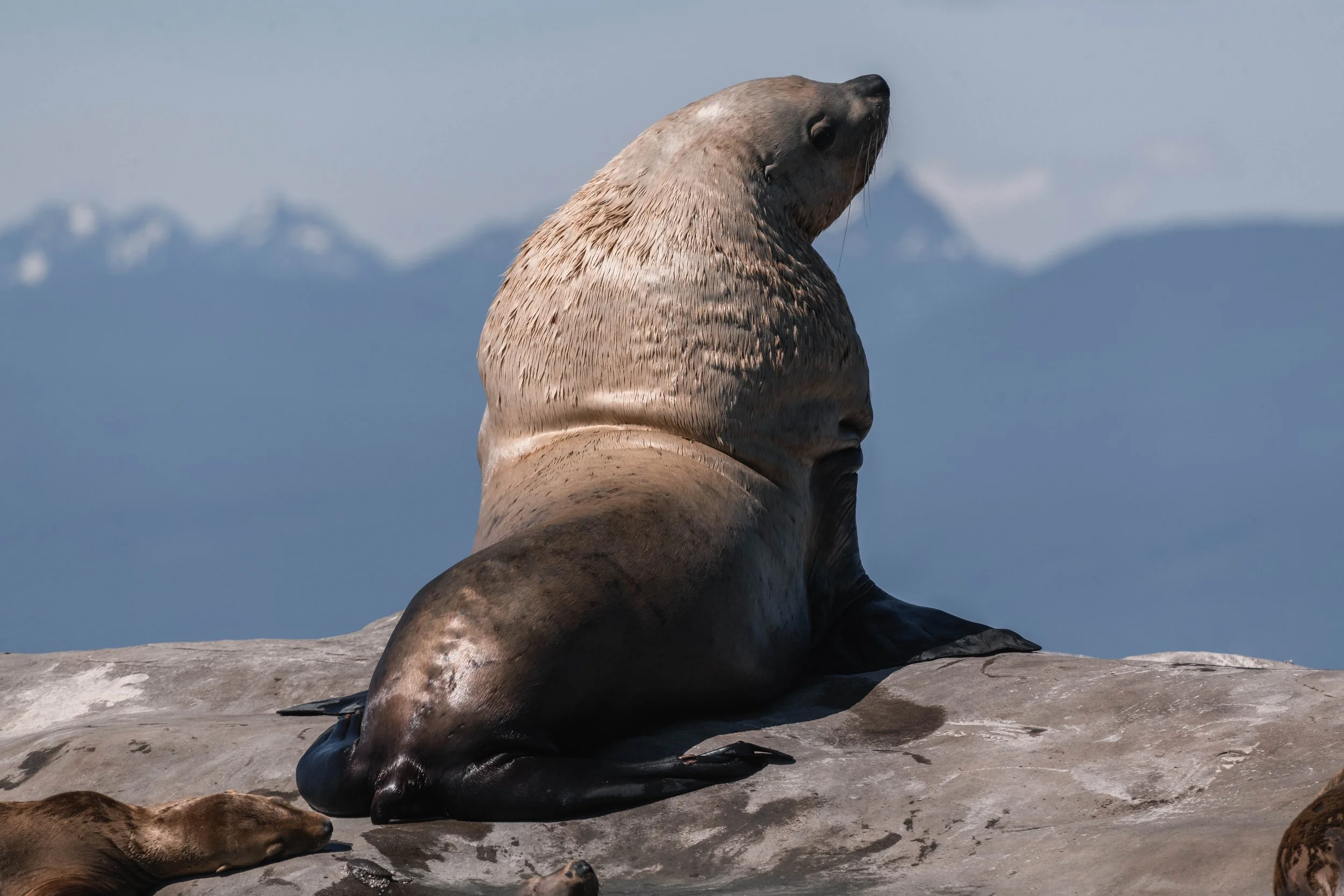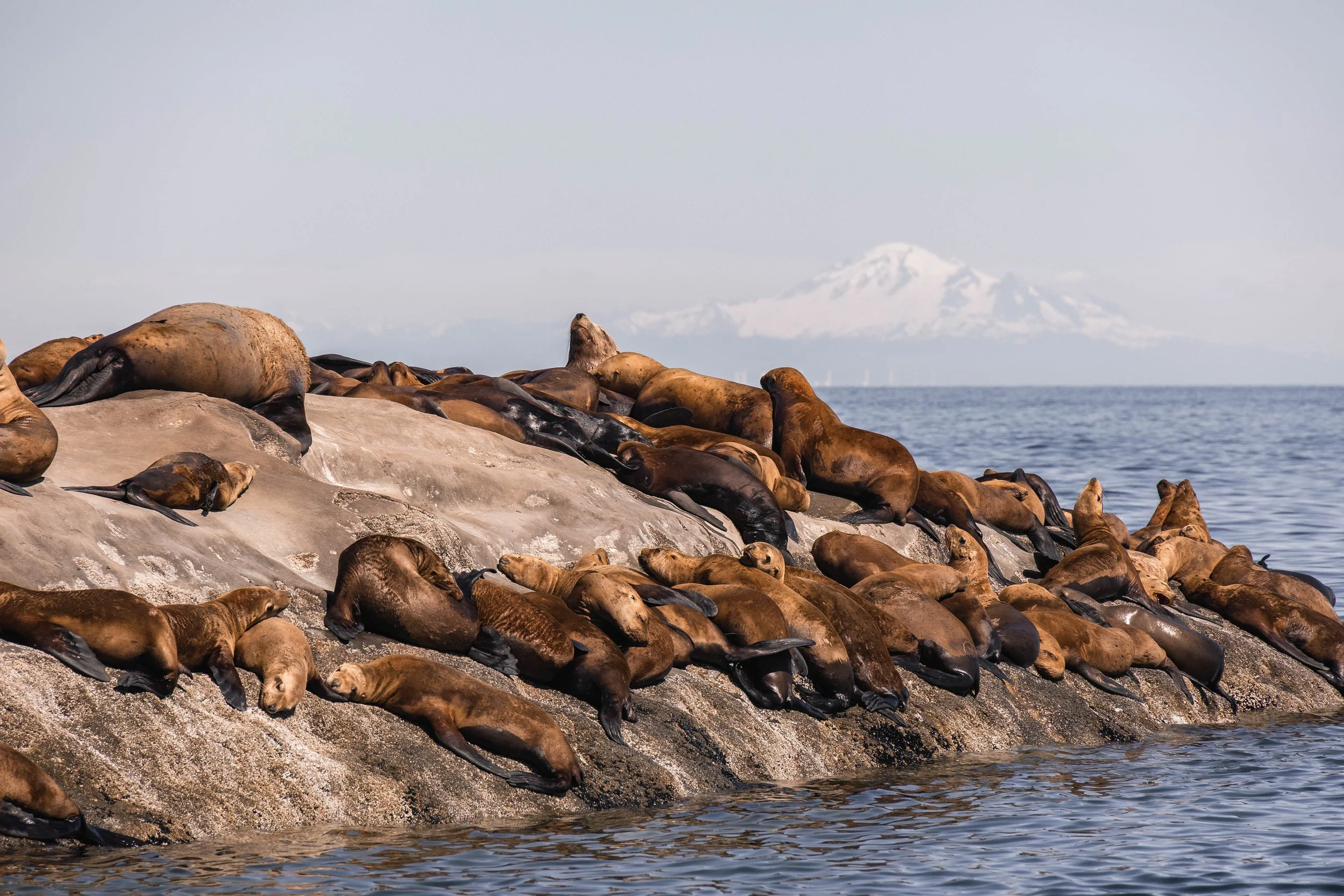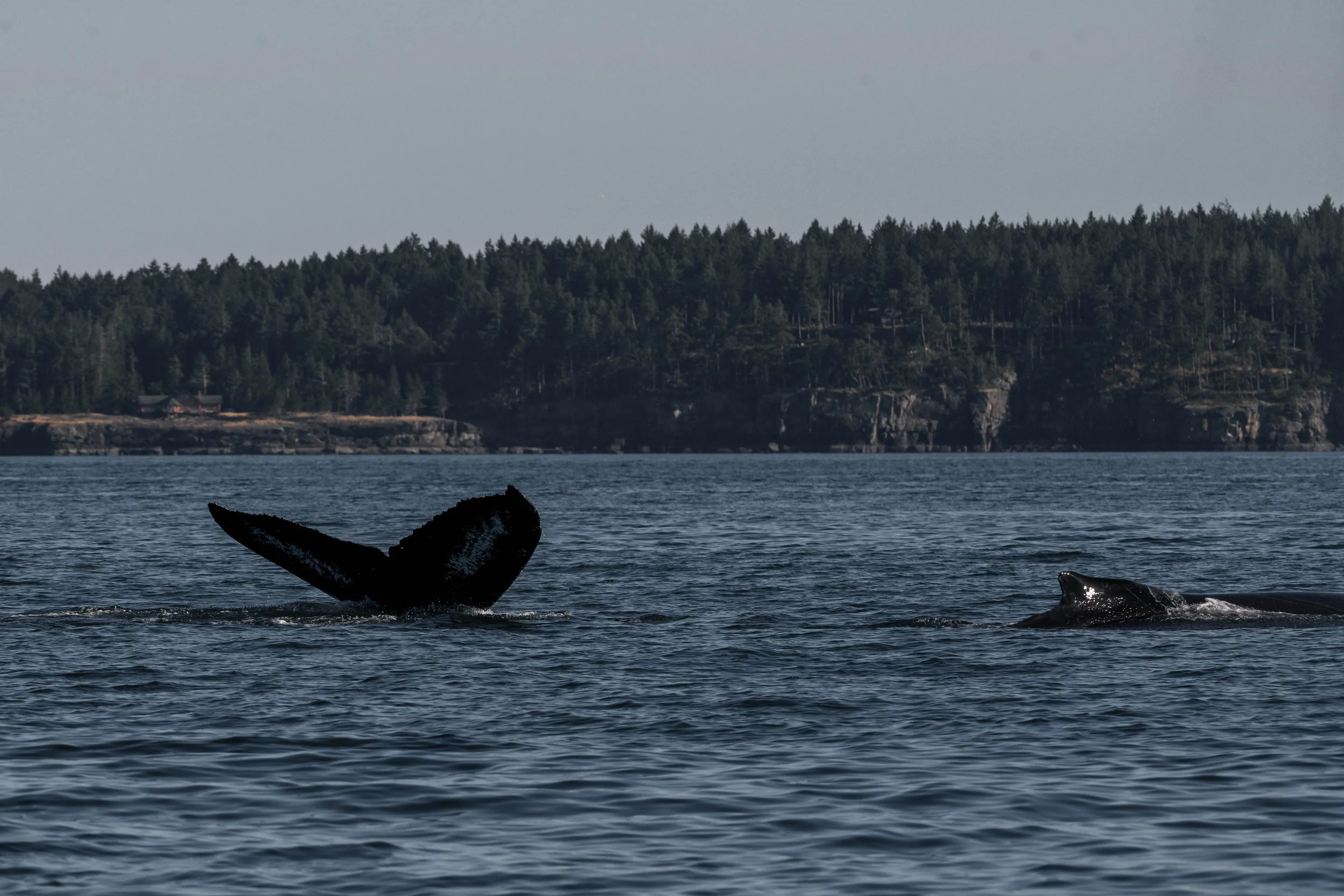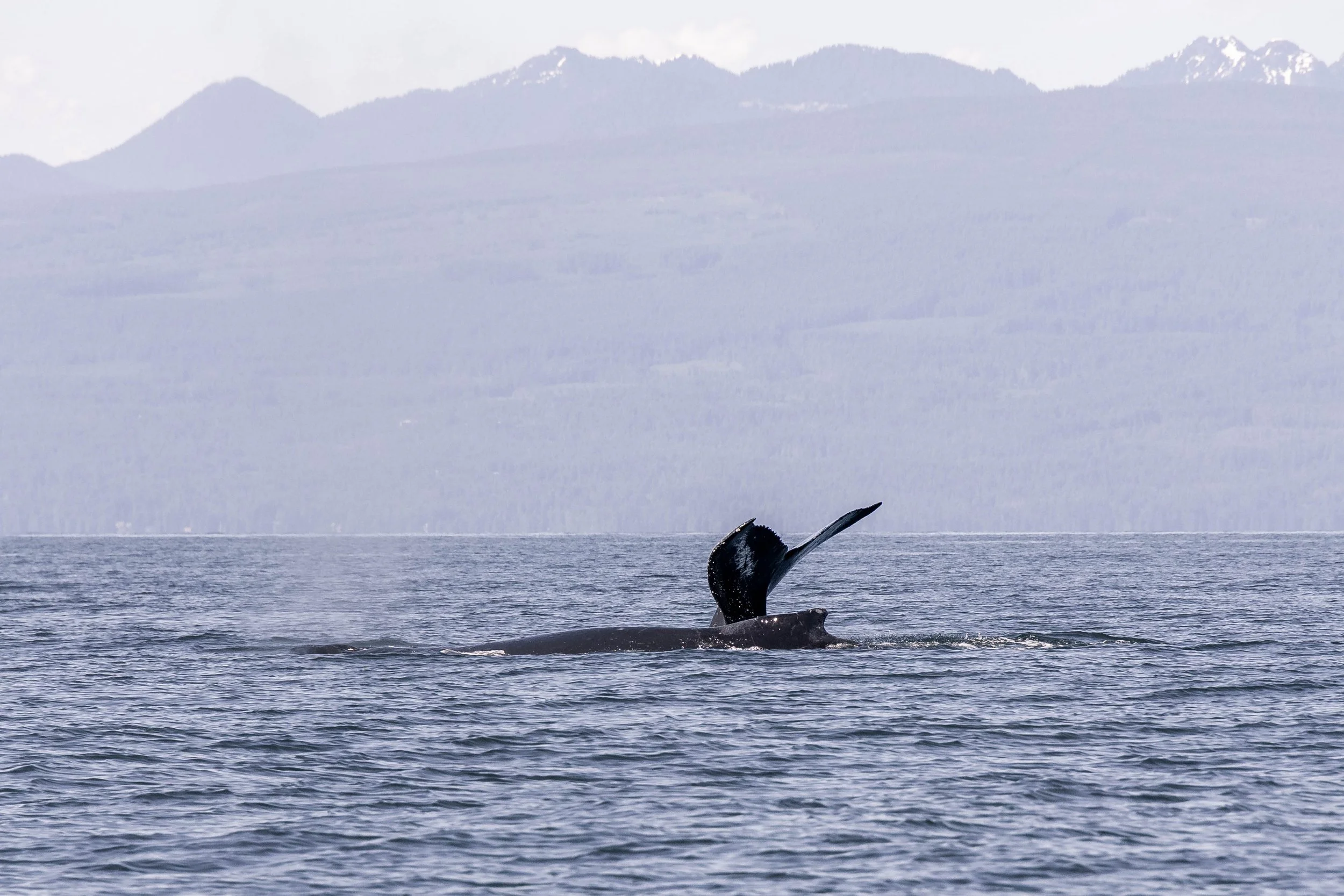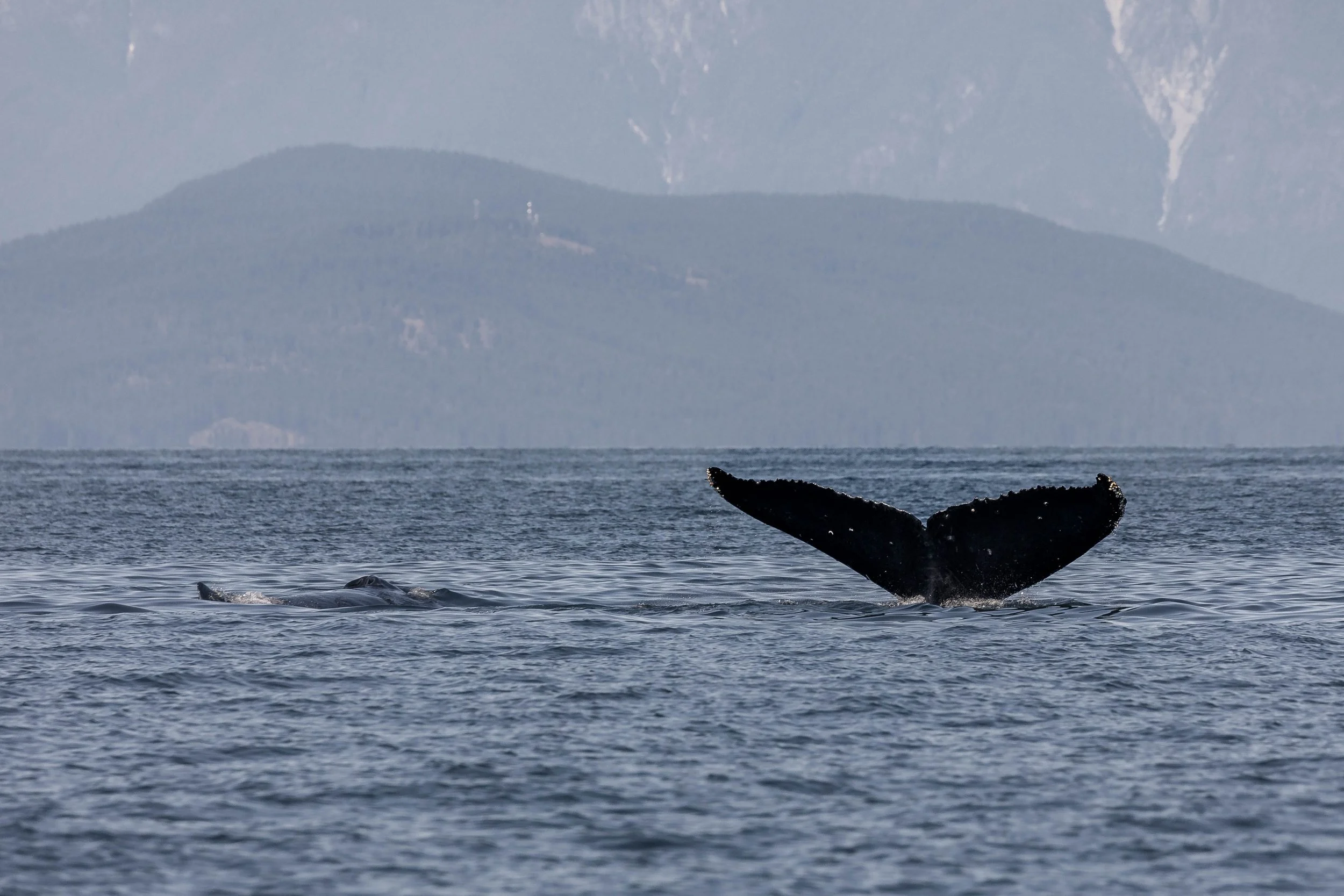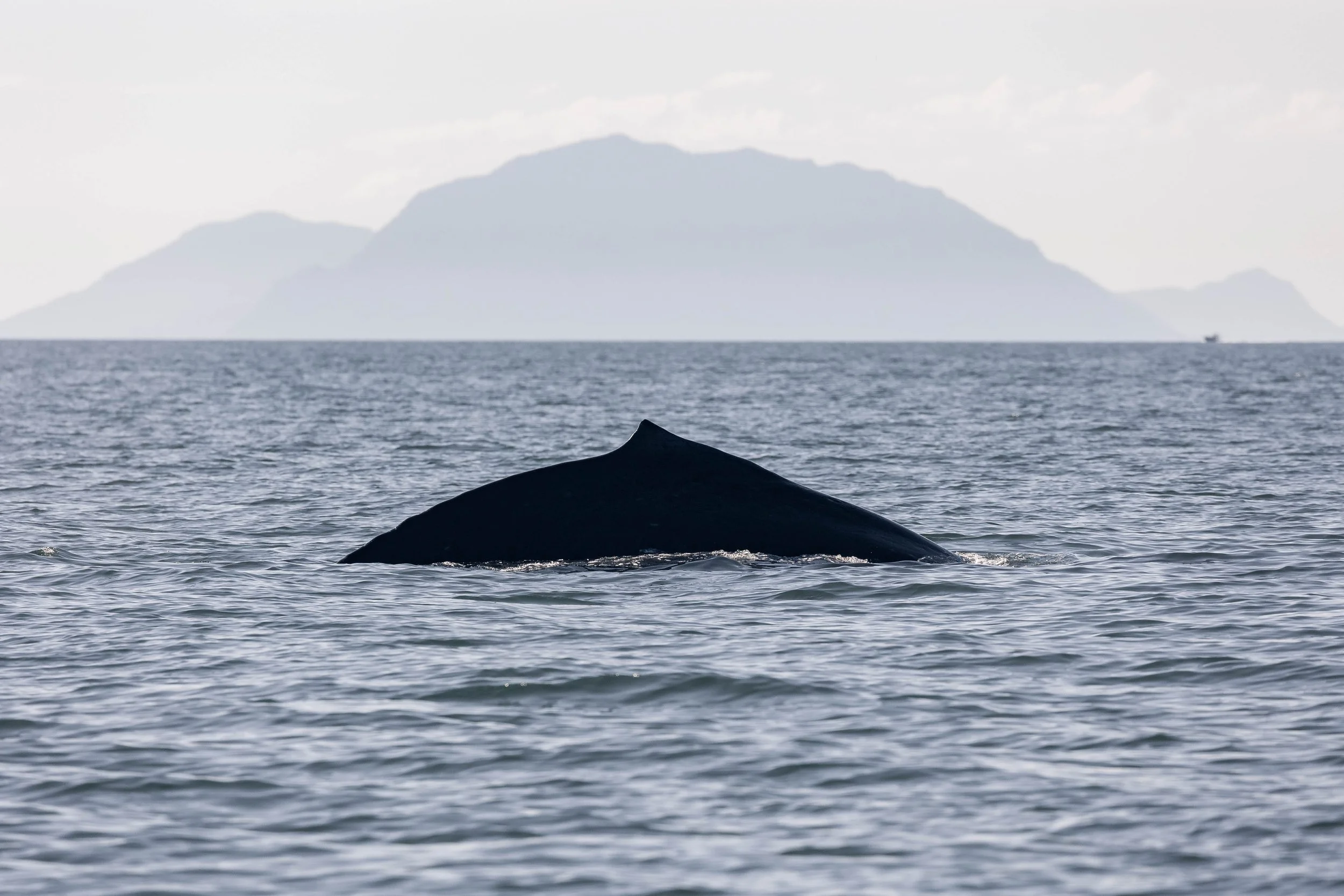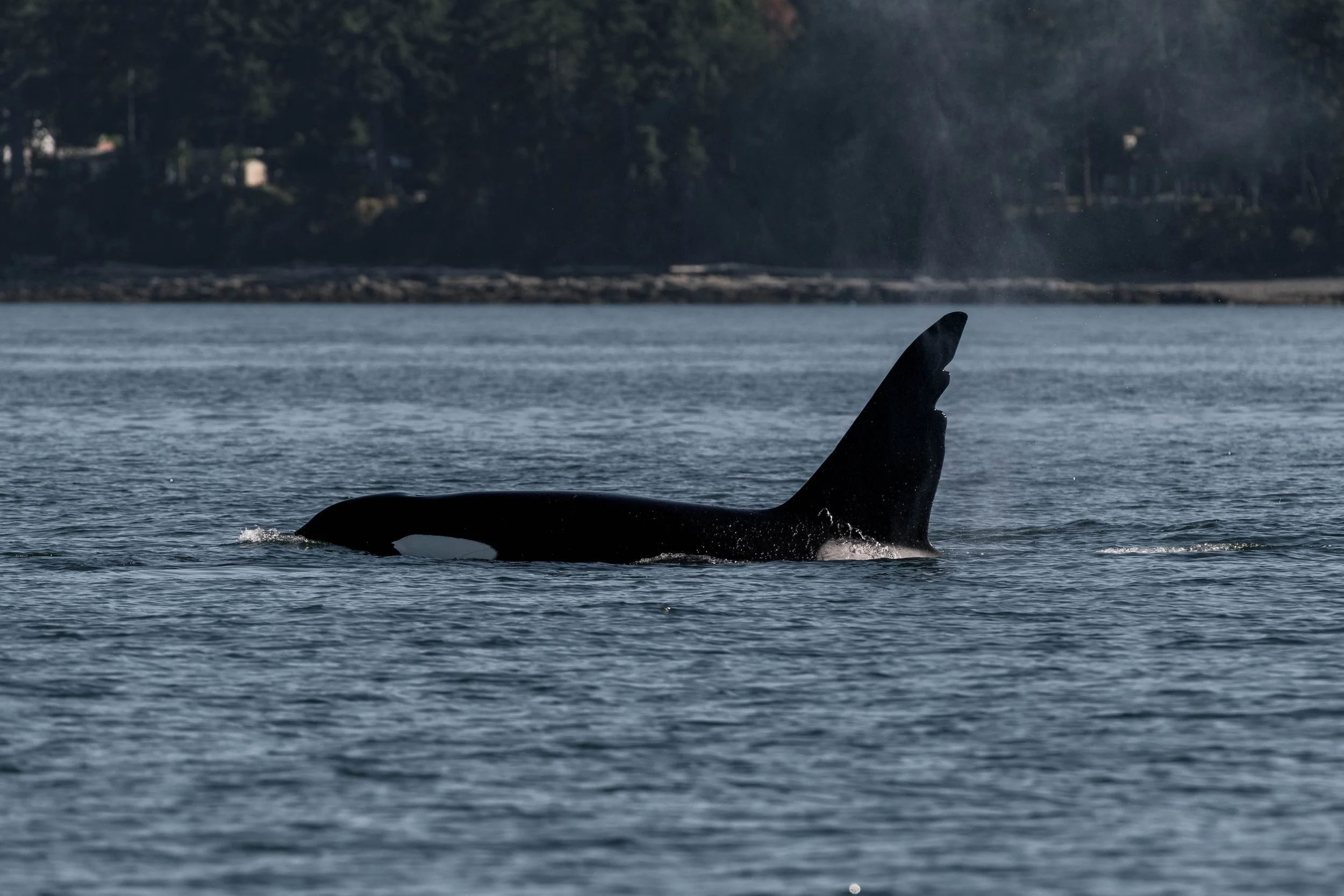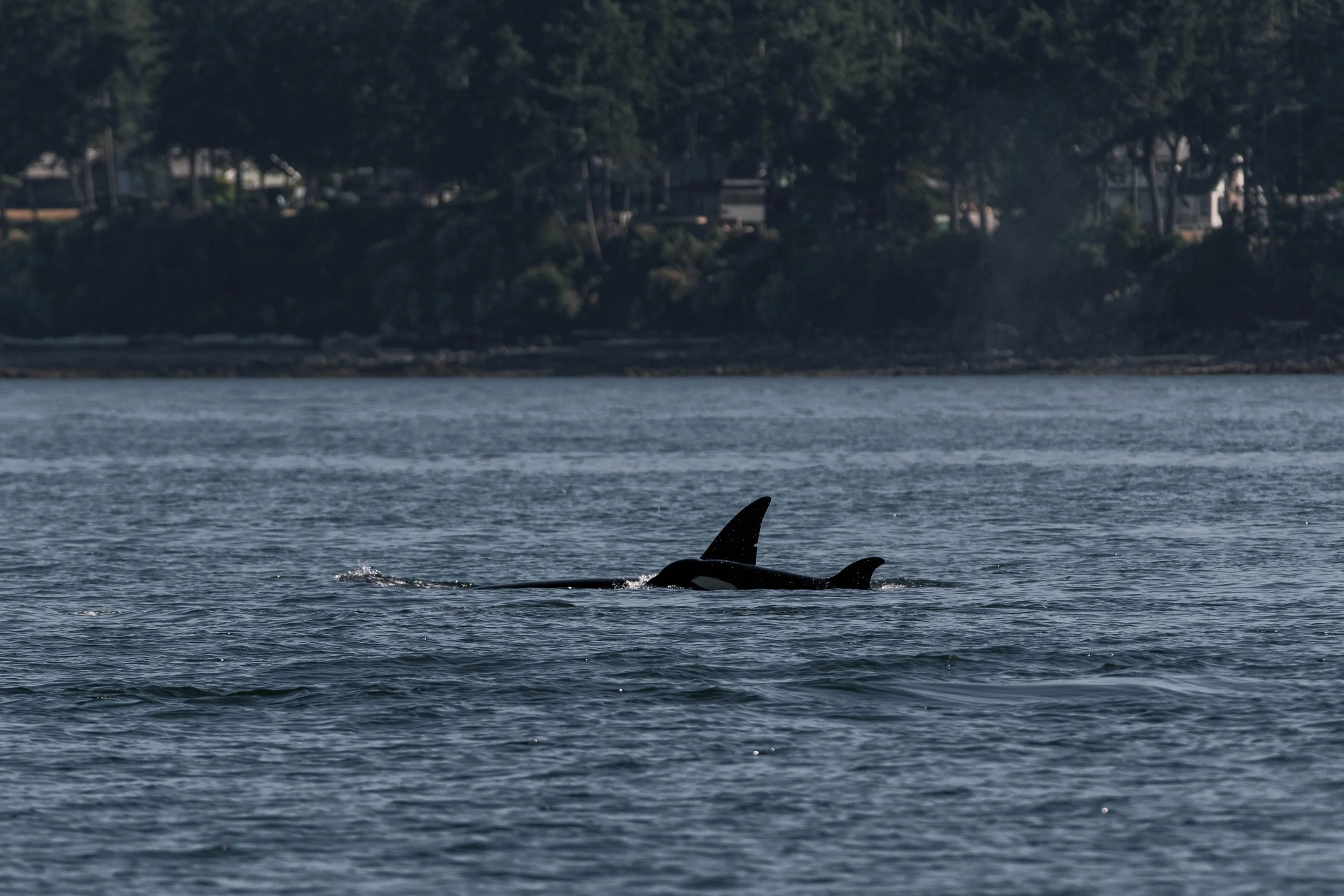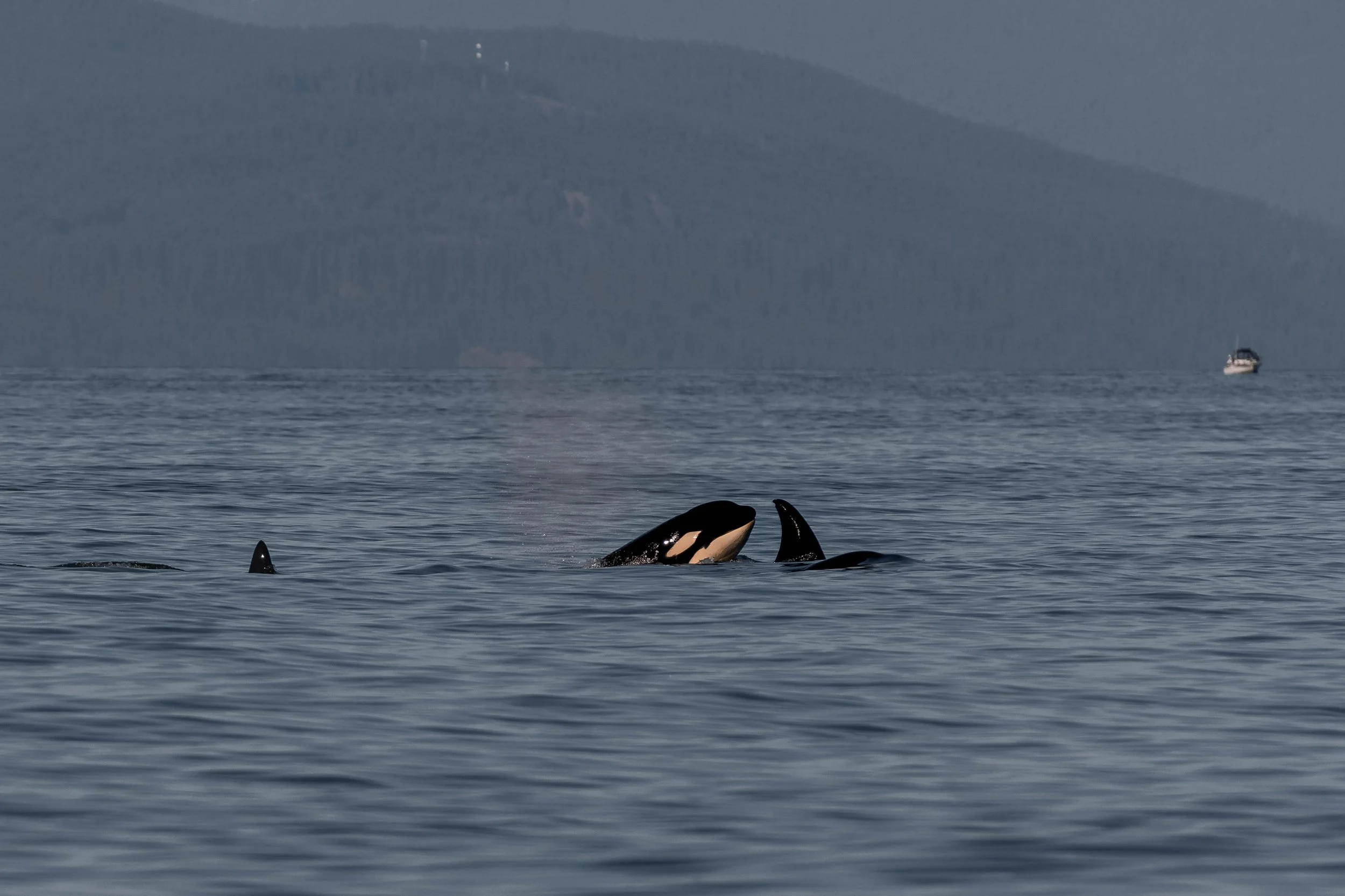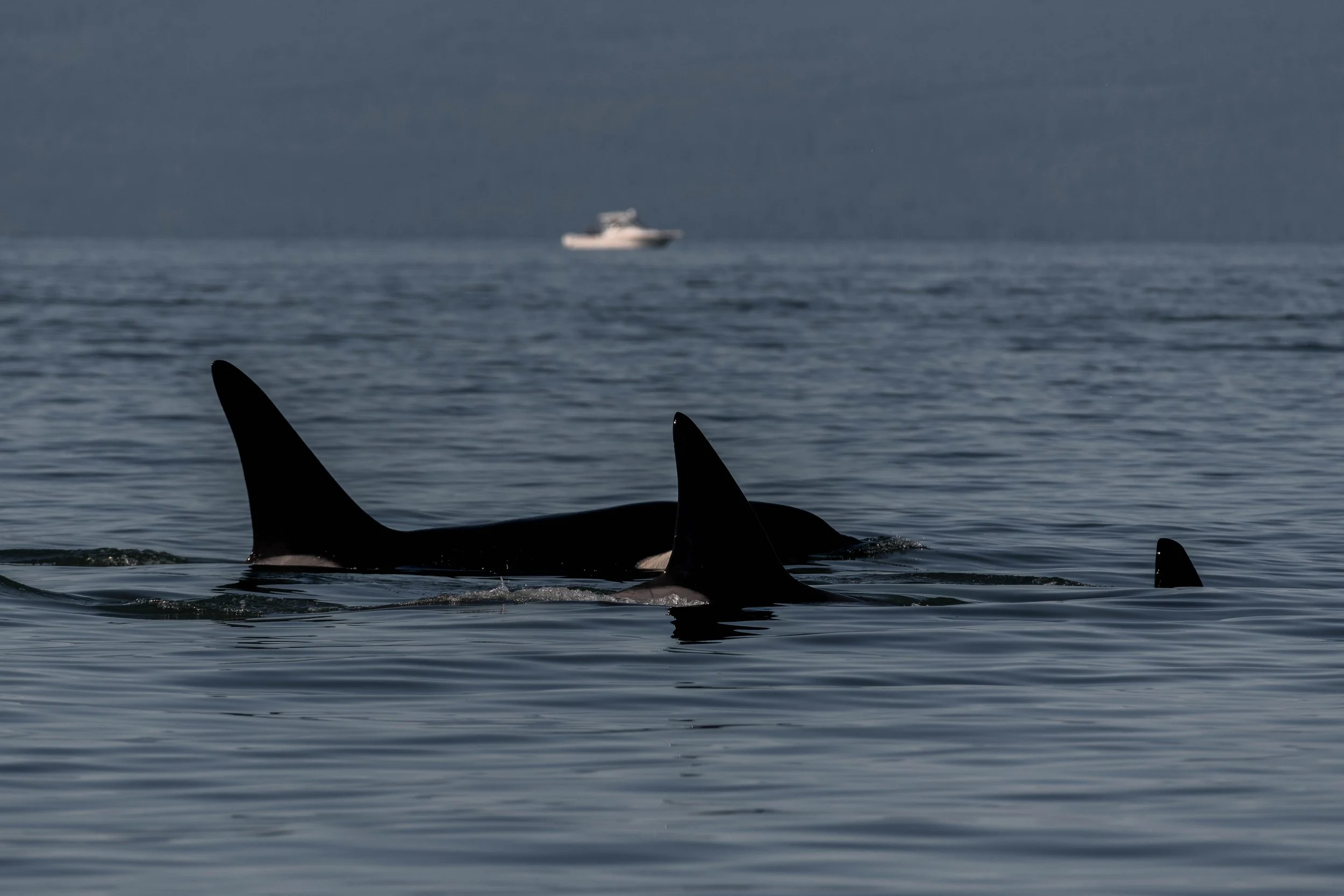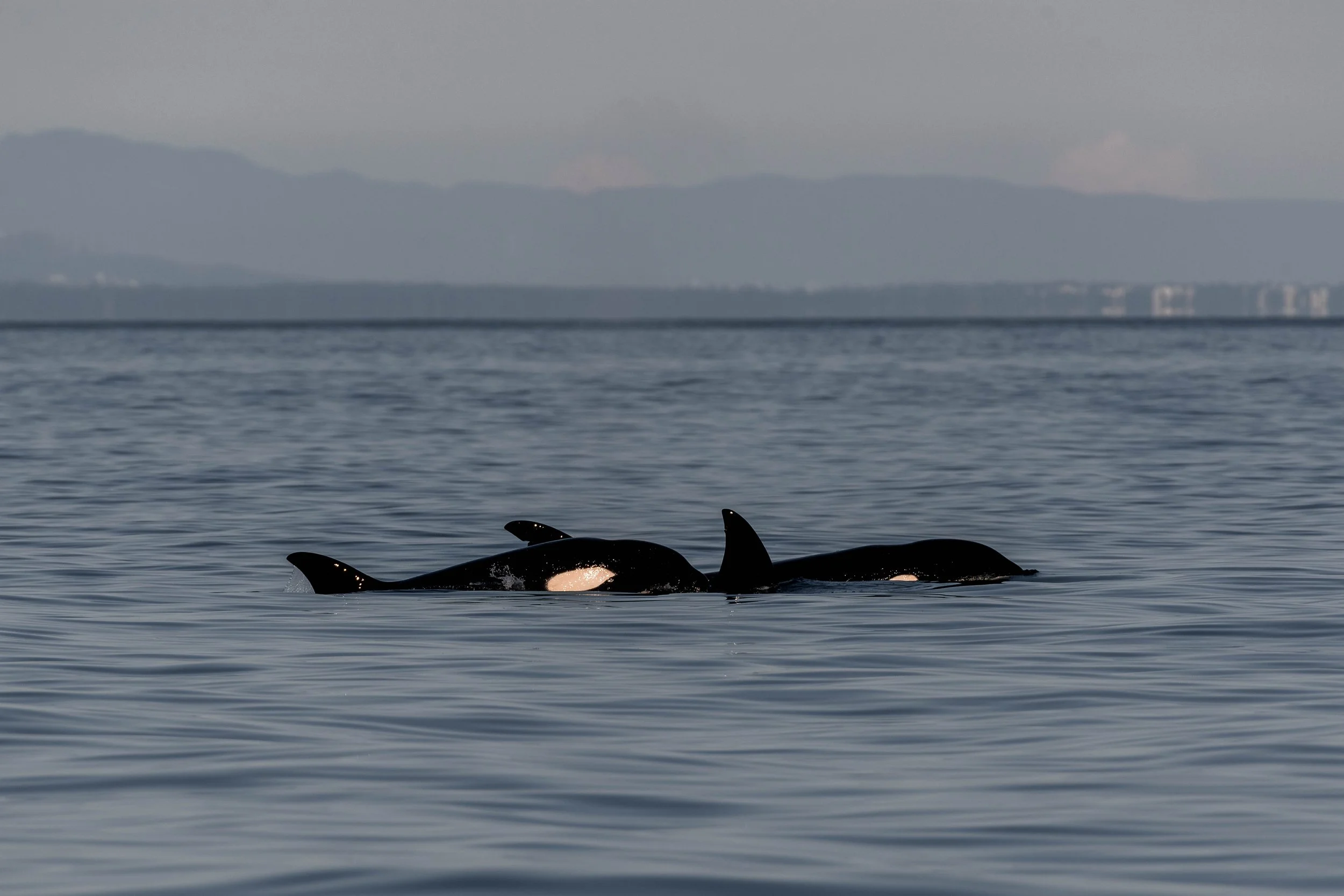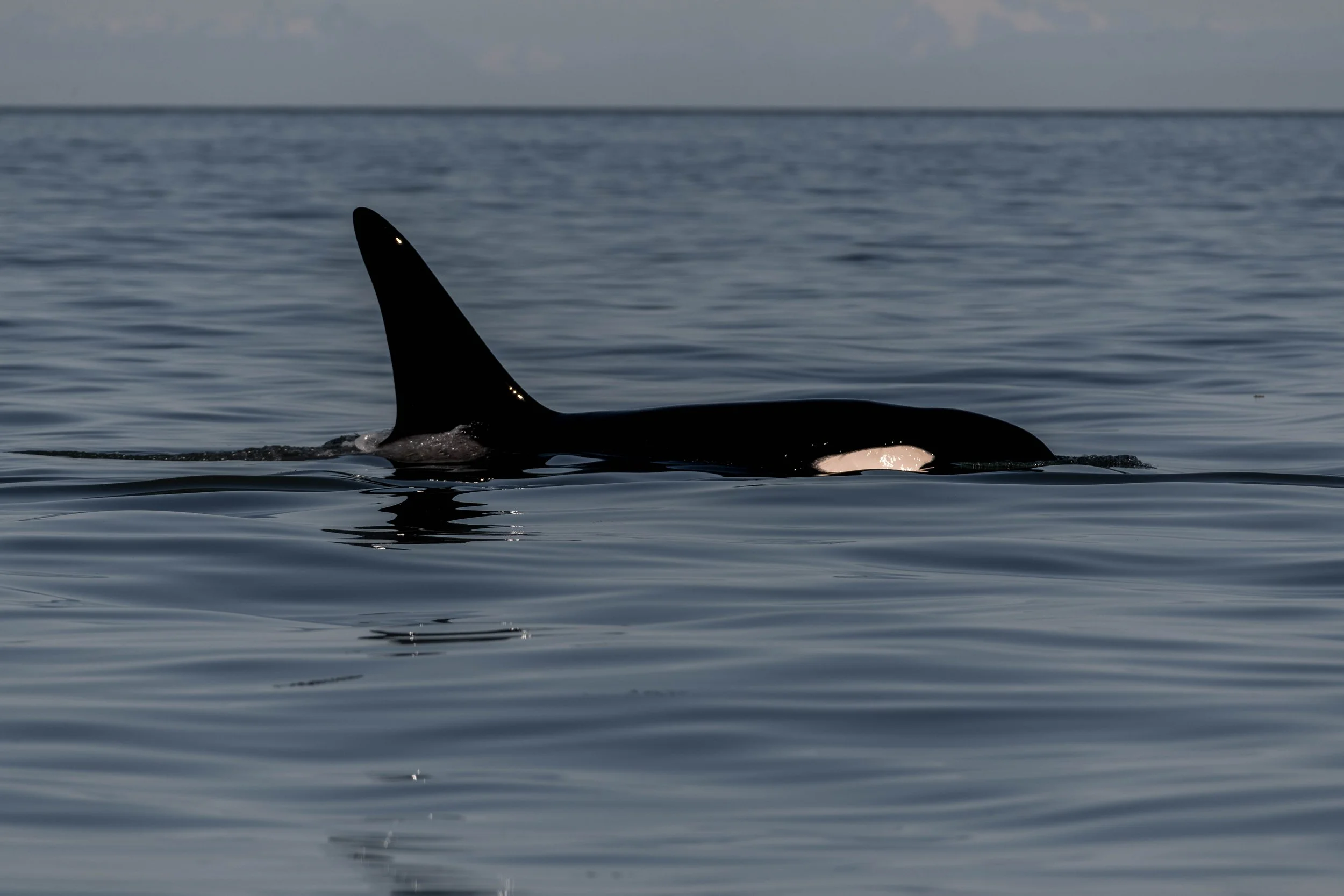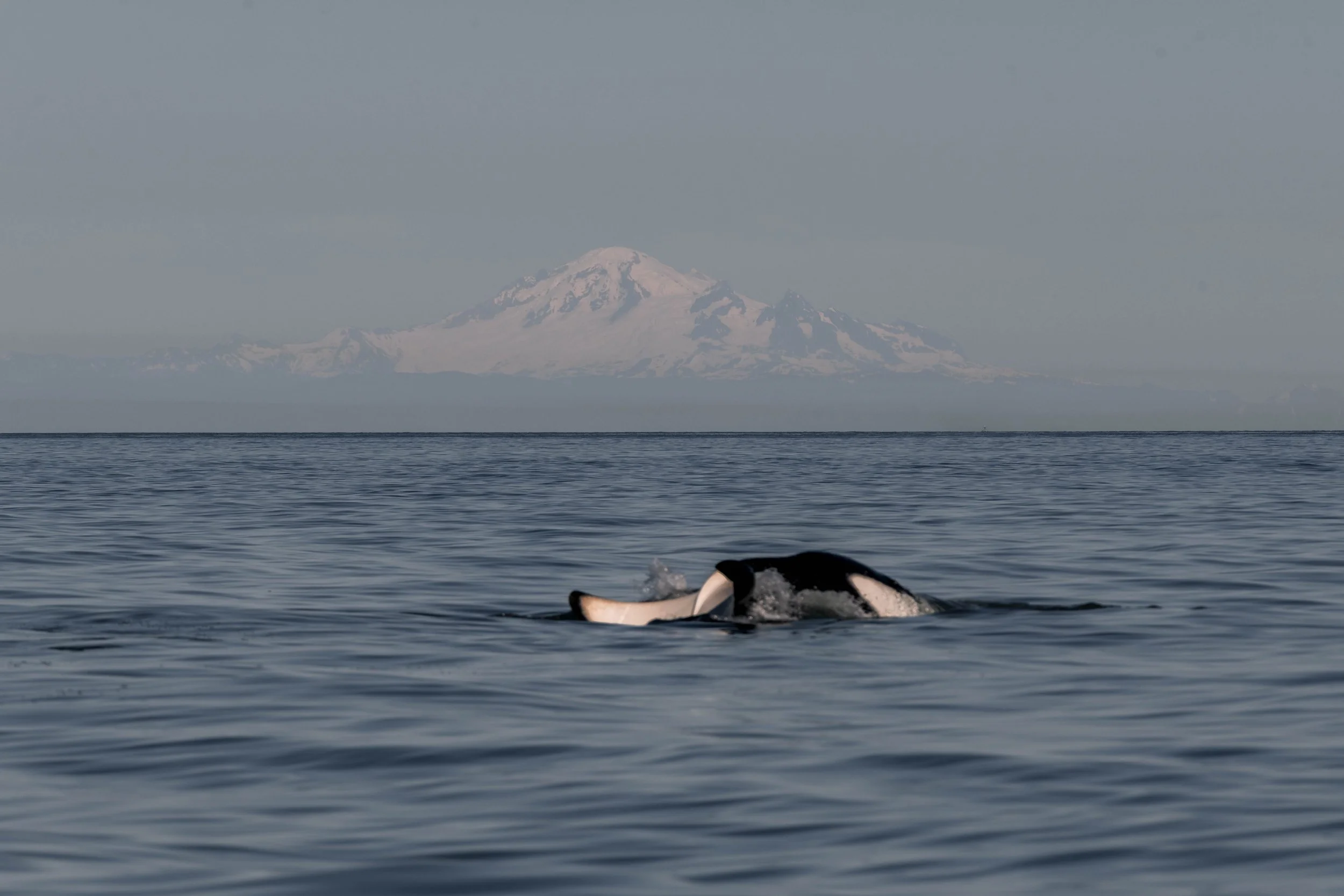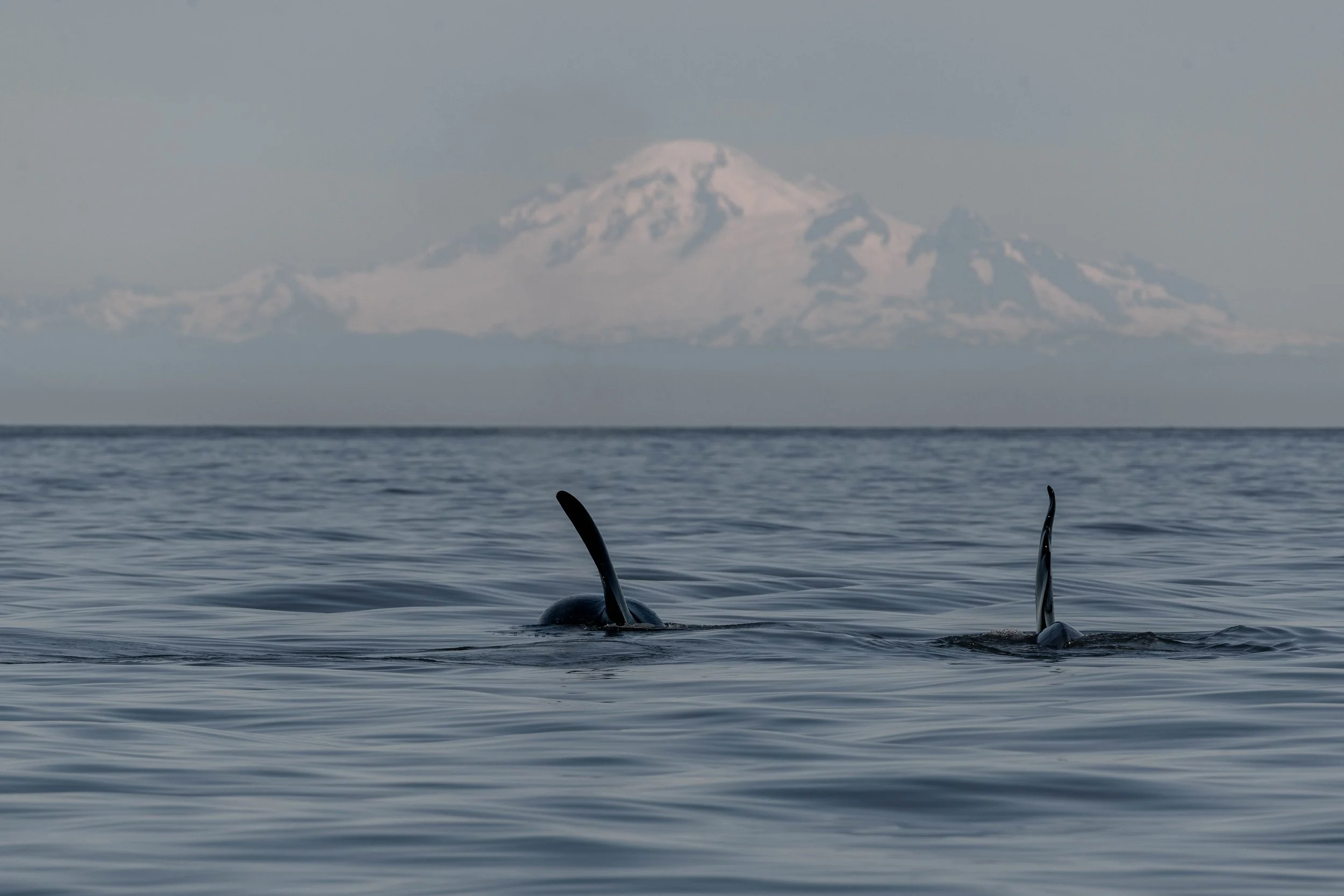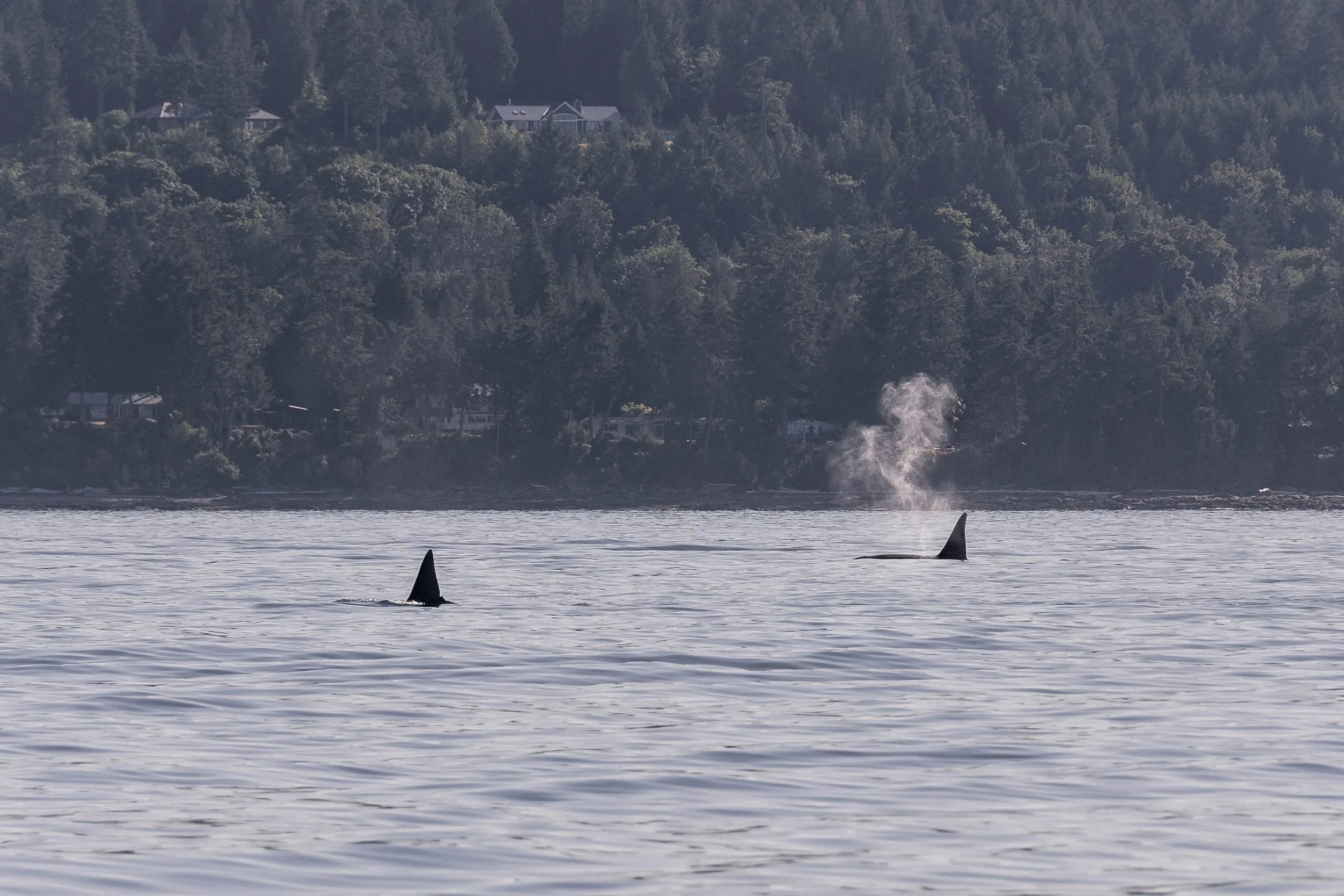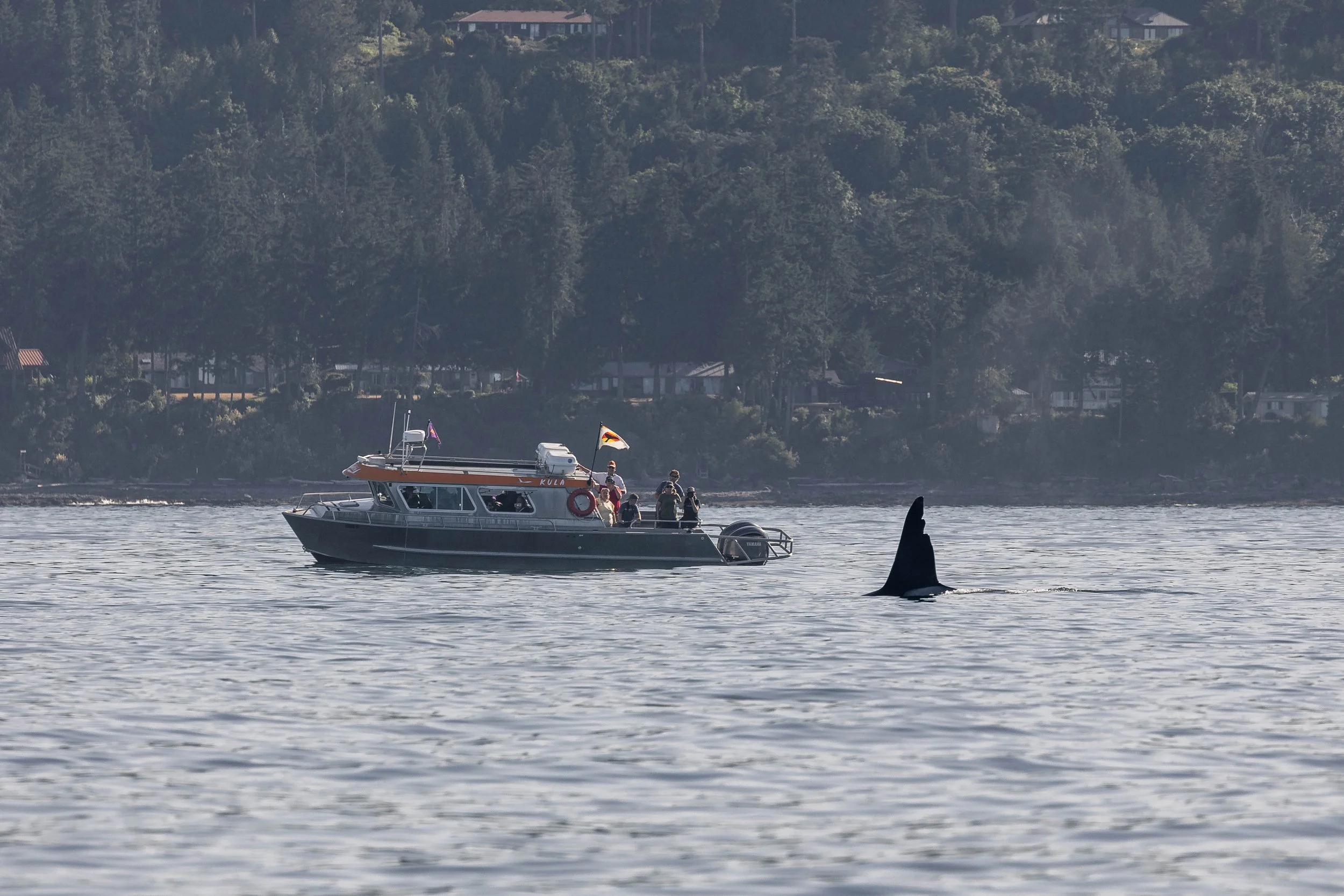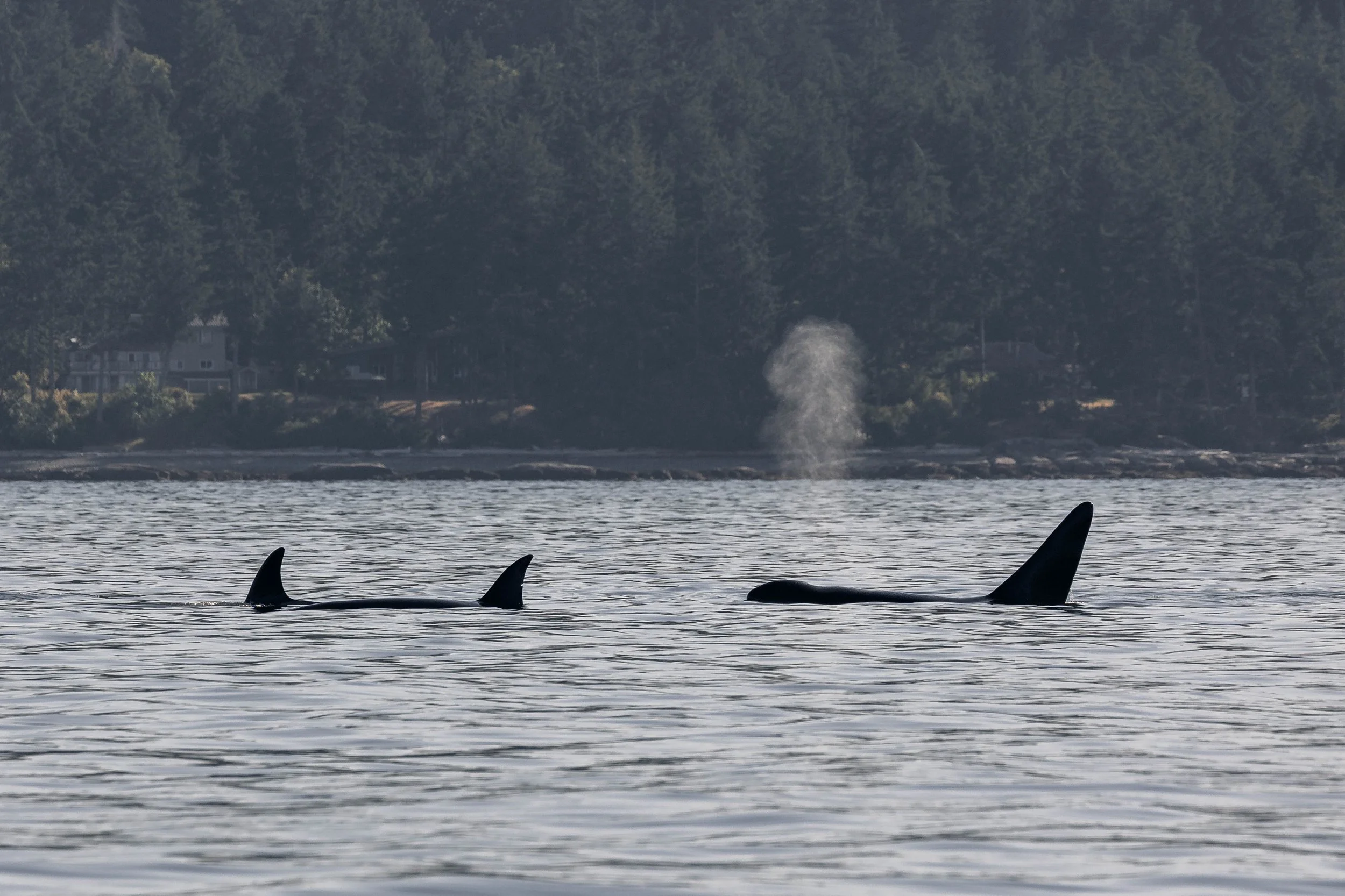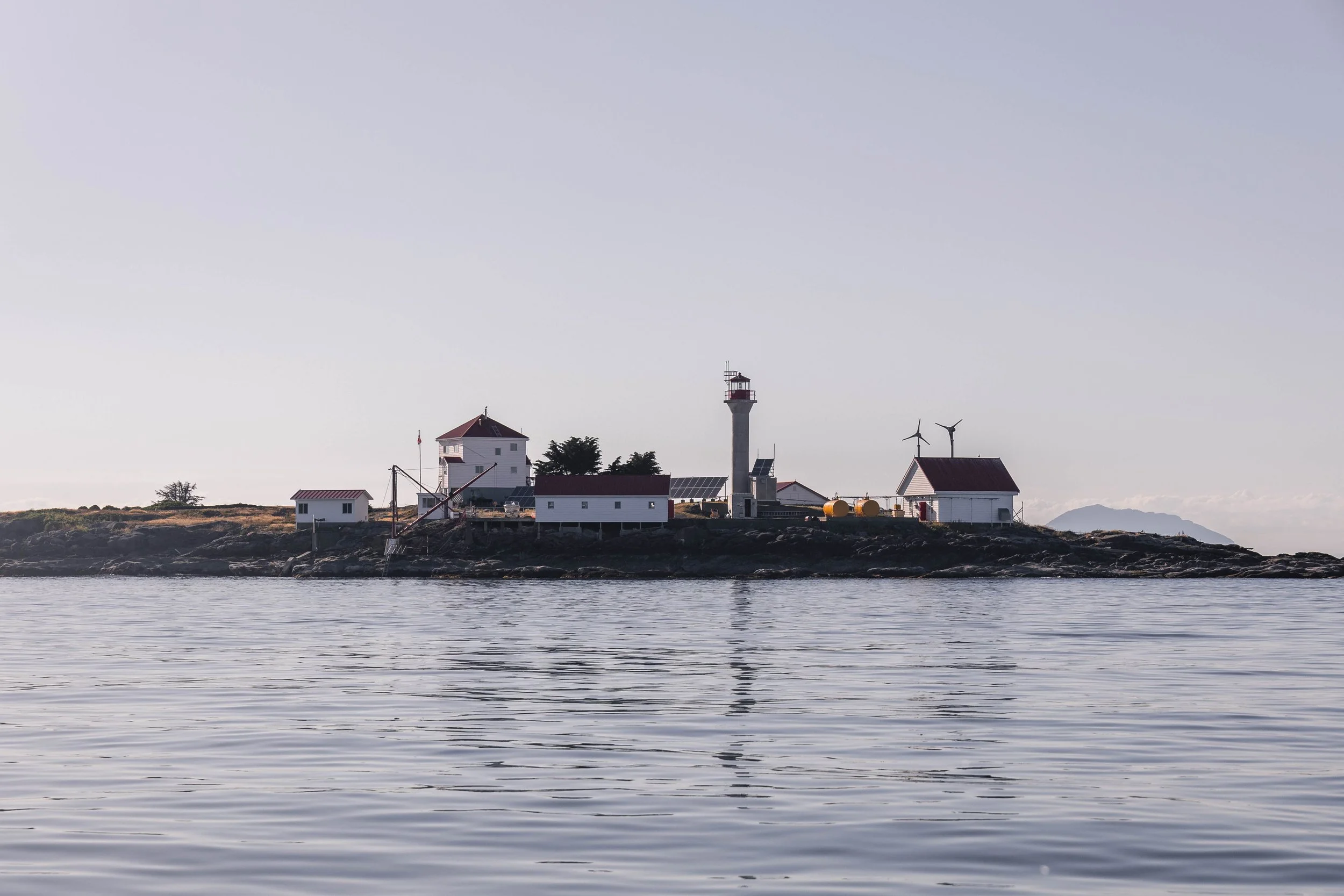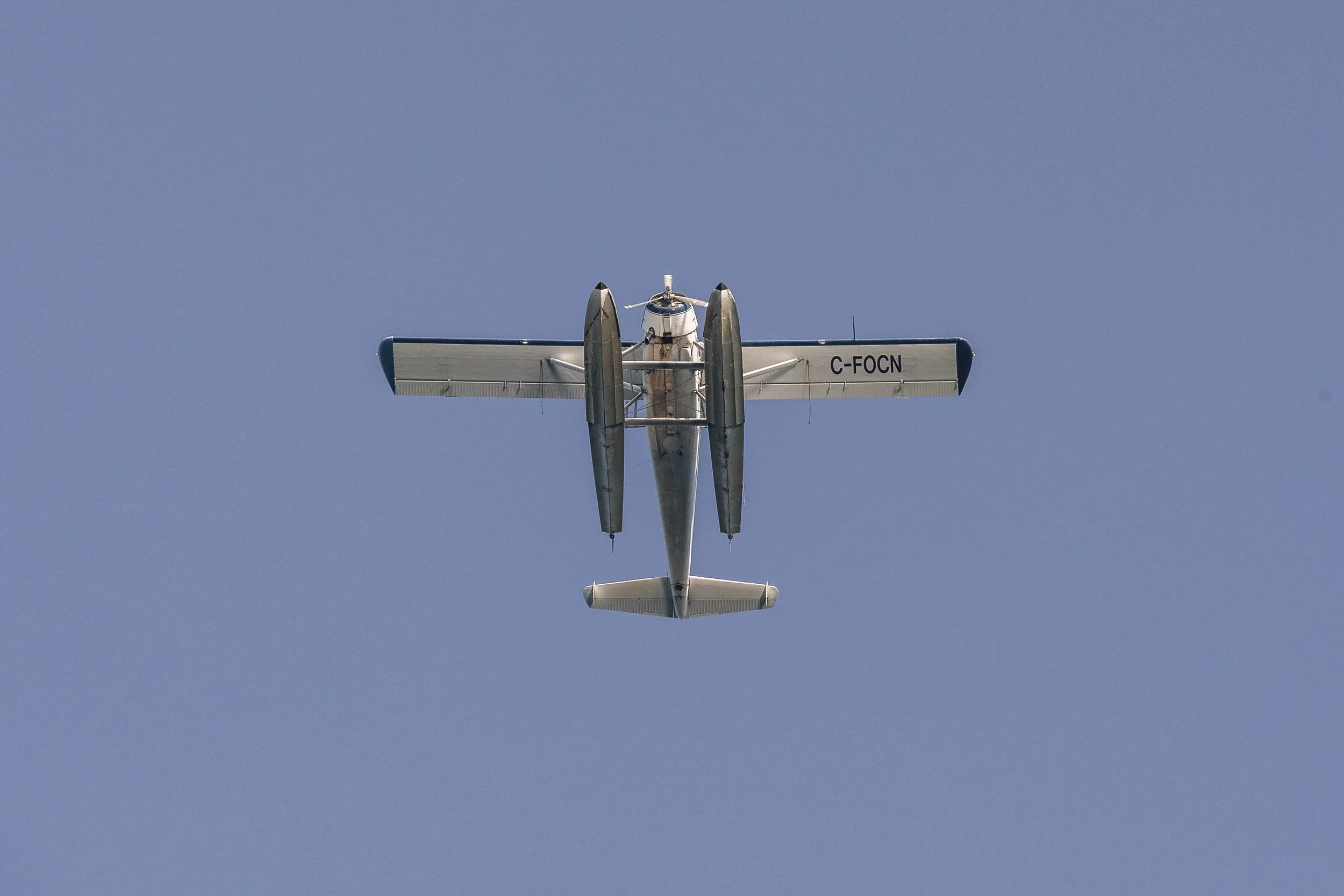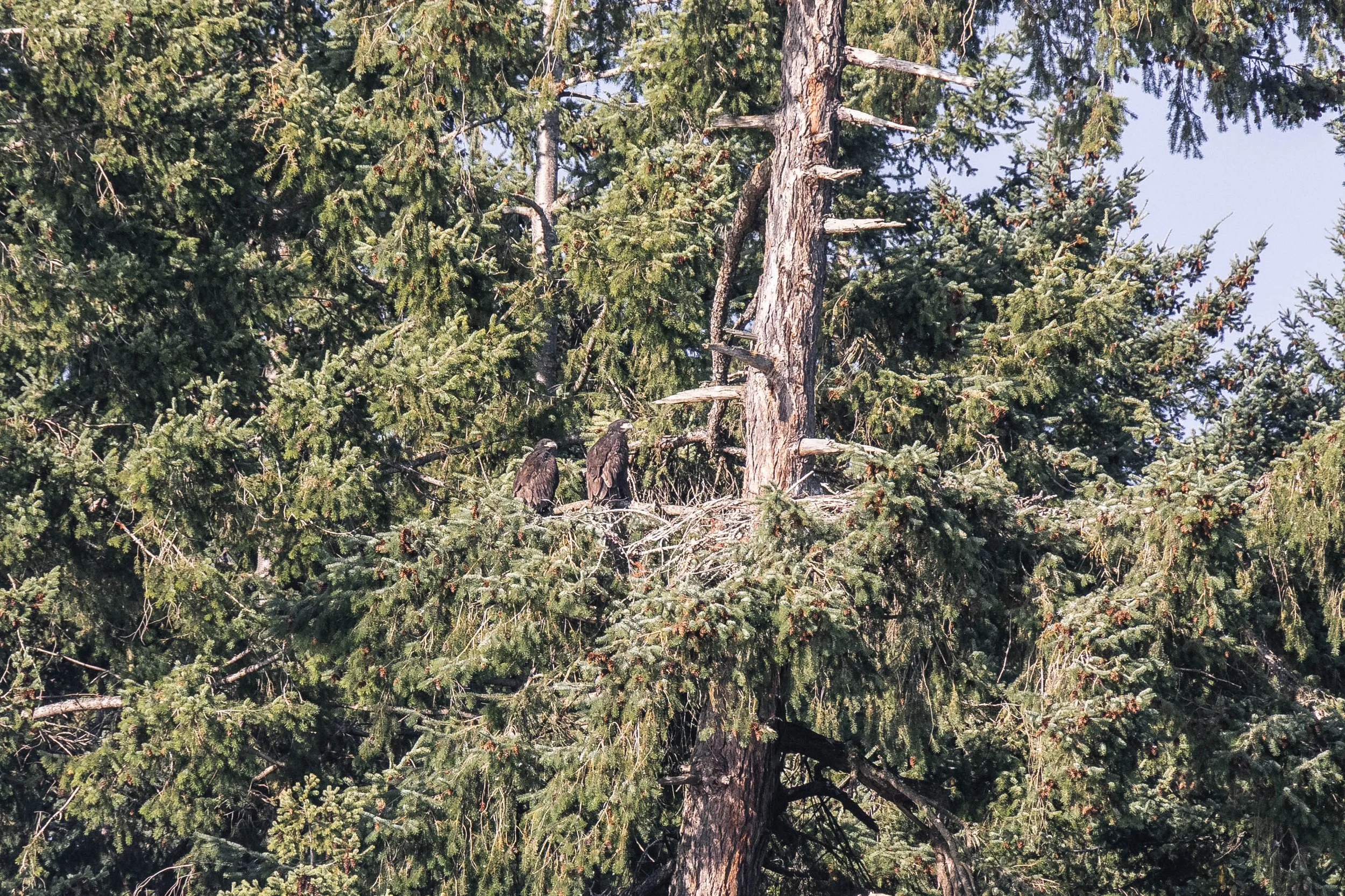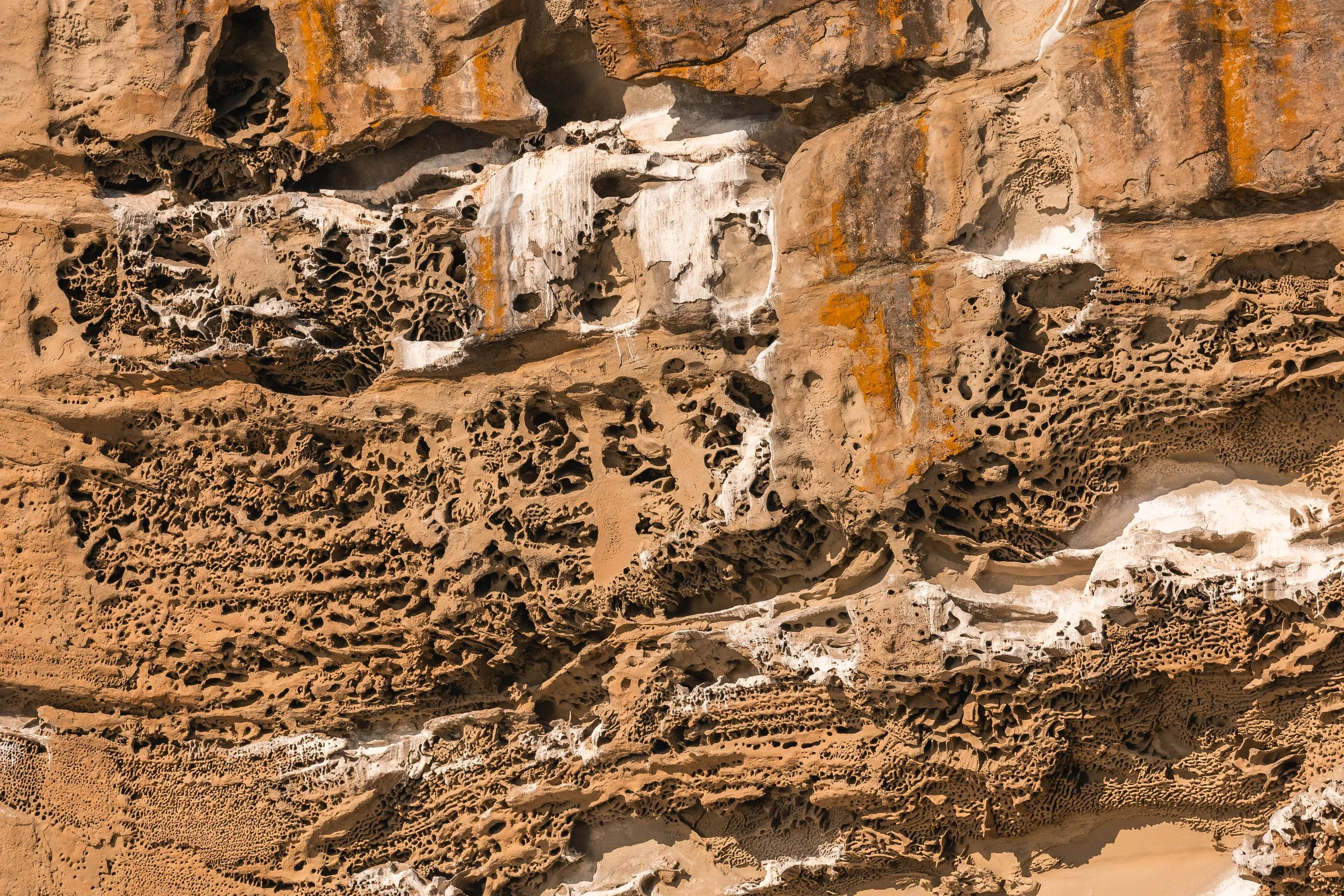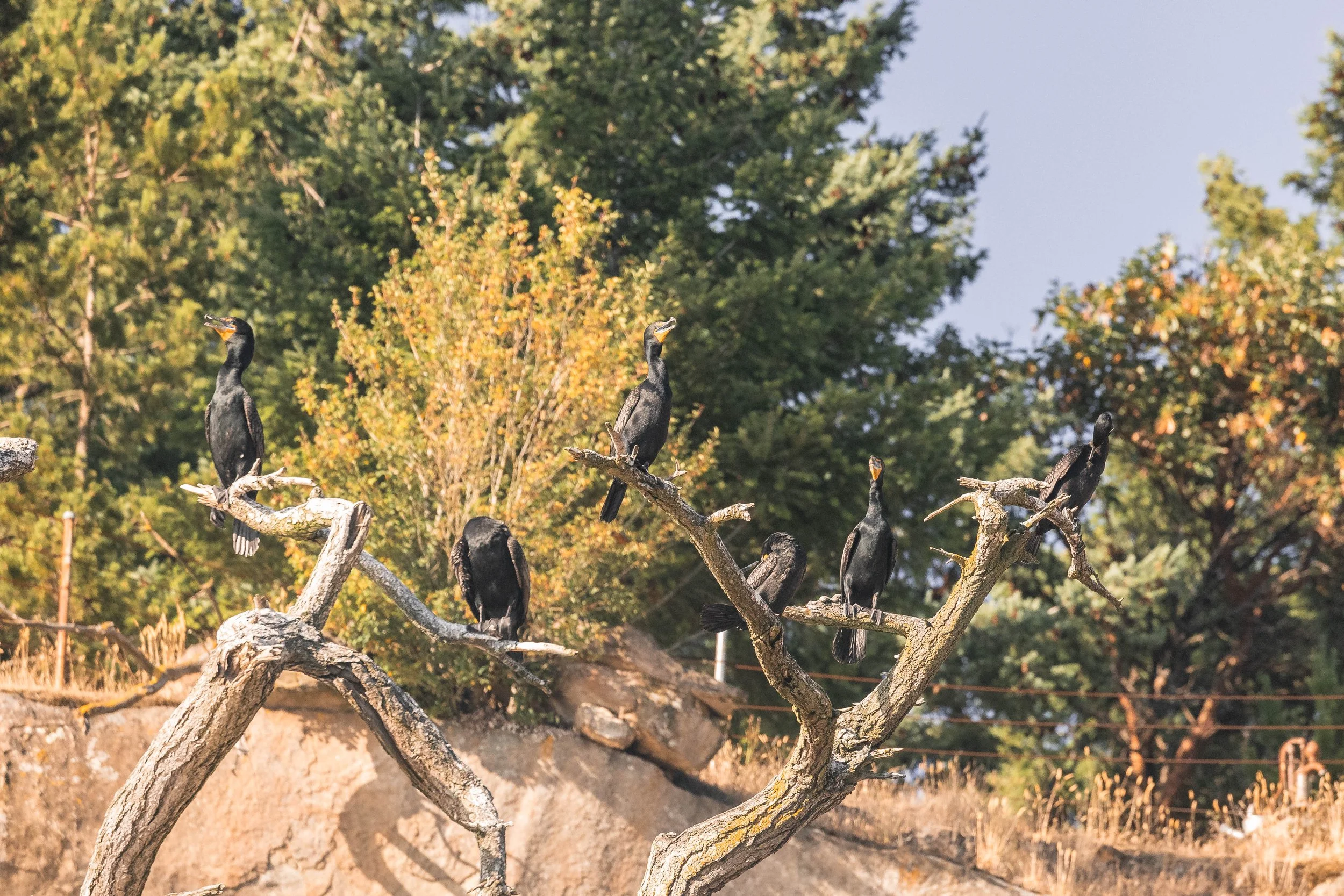July 1, 2025, 3:30 PM - Canada Day T-Party: Part 2
Canada Day continues, with promises of a great tour in store for us. It started with us headed south, aiming to search a bit in the Southern Gulf Islands to start things out. We travelled through until we arrived at the first wildlife stop of the day: Stinky Rock.
Stinky Rock was teeming with wildlife as we approached. Our Harbour Seals were busy soaking up the sunshine, snoozing and lounging in the shallows. We are just starting to see our first seal pups of the season show up now, so we are always peeking amongst the rocks to try and see some adorable baby faces! While we didn’t see them today, regardless, we loved seeing their big, round eyes curiously observing us as we gently drifted by.
Over on the steeper side of Stinky, our Steller Sea Lions continue to reign, king of the hill! Our massive male towers over the rest, carefully observing his surroundings and loudly asserting his dominance. He lumbered along, growling and belching as he went. While most of our Steller Sea Lions have headed north to breed, we still have an impressive 40-50 strong colony at Stinky Rock! Will they make Stinky Rocks a new rookery, or breeding ground, in the future? Only time will tell, but if we get to see more tiny baby faces at Stinky in the coming years, that feels like a win to us!
There was one other set of eyes peeking at us - a pair of striking yellow ones. A Bald Eagle loomed from the top of Stinky Rock, eyeing up the teeming waters below. While once on the verge of extinction, thanks to conservation efforts (namely the banning of DDT, a pesticide that was the leading component to their near extinction), these majestic raptors are once again thriving, with many chicks being born and raised along our coastlines.
Our time at Stinky Rocks was soon over, and we continued on our way to try and find the trip’s main objective: some whales! We headed into the Strait of Georgia, scanning all around, looking for blows or flukes, or the tell-tale signs that there were whales nearby. At this point, our boats split up, covering as much ground as we could to raise our chances of finding whales. This decision led to our boats successfully finding whales, so successful that we had different whale encounters going on at the same time!
Our Semi-Covered vessel Kula and our Open Zodiac vessel Keta came together to observe a pair of humpbacks. They had located a duo that could be identified by both their flukes as well as their unique dorsal fins! They had found Astroboy (BCX2152) and Niagara (BCY0057), two whales seen in the area quite frequently lately. These two were busy travelling along as we observed them, and they briefly came over to Kula to peek at the boat. Mugging, or the act of a whale coming up to a boat on its own accord, is a rarely observed behaviour that we cannot encourage. Thankfully, shortly after the two took a peek, they continued on their way, returning to travelling and diving along.
At the same time, our Open Zodiac vessel, Cascadia, had found another familiar fin. They were with Anvil (BCZ0410), a large female humpback who regularly spends the season feeding off of Nanaimo’s coastline! Anvil has brought two calves back to our area in recent years (2022 and 2024) - if she keeps that streak going, she might be pregnant right now, and busily feeding in preparation for giving birth this winter!
After a short encounter with these humpbacks, the pairings mixed it up a bit. Astroboy began associating with a humpback that sadly never fluked, making it very difficult for us to find any matches. They currently remain unknown, but we will update this blog if we confirm their identity! Niagara also found a new travel buddy, this time with Barracuda (BCY0649).
We were eager to search for the large T-party (multiple Transient orca pods travelling together) that we had found during our morning excursion this afternoon, so after spending our time with these humpbacks, we headed over and had no problem finding the group of 22 whales travelling together. The following whales were present:
T002C Tasu ♀ (1989)
T002C1 Rocky ♂ (2002)
T002C3 Lucy ♀ (2011)
T002C5 Zippy (2020)
T002C6 (2025)
T036 Flapjack ♀ (≤1970)
T036B Tattertip ♀ (1998)
T036B1 Bhotia ♀ (2009)
T036B1A Maple ♀ (2025)
T036B2 Greenfelder ♀ (2013)
T036B4 Auk ♂ (2024)
T099 Bella ♀ (1984)
T099B Holly ♀ (2007)
T099C Barakat ♂ (2009)
T099D Puck ♀ (2015)
T099E Qwiin qwiin oo qwii la ♀ (2021)
T065 Whidbey II ♀ (~1971)
T063 Chainsaw ♂ (~1978)
T069 Komox ♀ (~1974)
T069C Kye ♂ (1995)
T069E Kodiak ♂ (2004)
T069F Kin ♂ (2010)
This was a true T-party, with lots of surface activity and socializing observed during our time spent with the orca. Usually, the transient orca need to remain stealthy and silent, since they don’t want to give their relatively intelligent prey the warning that they are coming, but during a T-party, that all goes out the window! The main purpose of these large gatherings is to socialize, and while they might not intake the calories that they require for the day while they are a part of these large groups, they have enough energy storage in their blubber that it’s okay. The Transient Orca have an abundance of food in the area, with so many seals and Sea Lions around (as we saw at Stinky Rock earlier), they don’t have many issues finding food. It seemed like the males were spending time together, while the females and youngsters were together a little ways away.
It was very fun to watch these whales having fun, seeing tails in the air, whales swimming sideways, spy hopping, and we even got to see some “sword fighting” going on amongst the males. There is evidence that young males, or less successful males, might do some practicing amongst groups of other males, developing skills and techniques that will help them be more successful in reproducing later in life. We tend to agree with this theory, especially after gatherings with lots of male whales in it like this! This does make logical sense, since most animals, only a small percentage of the males will father most of the calves in a population, and they are usually some of the oldest and largest in the population. How will these young males get to that stage if they can’t practice?
The females were also interesting to watch, and we enjoyed every moment spent with this T-party. But all good things must come to an end, so we left them behind and headed back toward Nanaimo. The trip concluded with one last stop at the Gabriola Bluffs to see the nesting cormorants there, and the Bald Eagles just a little south of the Bluffs. It was a beautiful end to an amazing tour! Please enjoy these photos taken by Marine Naturalists Aly Kohlman, Desarae Poier, and Jordan Robinson!
Harbour seals hauled out at Stinky Rock. Photo by Jordan Robinson.
Harbour Seals relaxing on the rocks. Photo by Aly Kohlman.
Bald Eagle watching us from the rocks. Photo by Aly Kohlman.
An itchy Steller Sea Lion. Photo by Aly Kohlman.
Stinky Steve ruling over his rock. Photo by Aly Kohlman.
Steller Sea Lions hanging out with Mt. Baker in the background. Photo by Desarae Poier.
The underside of Astroboy’s tail. Photo by Aly Kohlman.
Barracuda diving beside Niagara. Photo by Aly Kohlman.
Astroboy lifting their tail to dive. Photo by Desarae Poier.
Our unknown with their fluke high in the air, with Niagara beside them. Photo by Desarae Poier.
Niagara’s fluke as they dive. Photo by Desarae Poier.
Niagara swimming sideways, with his pectoral fin visible. Photo by Desarae Poier.
Barracuda diving with Niagara in front of her. Photo by Desarae Poier.
Astroboy diving with a friend to their left. Photo by Jordan Robinson.
Astroboy’s dorsal fin. Photo by Jordan Robinson.
Astroboy going for a dive. Photo by Jordan Robinson.
T036B1 Bhotia and T099B Holly. Photo by Aly Kohlman.
T036B Tattertip and T036B4 Auk. Photo by Aly Kohlman.
T063 Chainsaw! Photo by Aly Kohlman.
T036B1 Bhotia surfacing with her calf T036B1A Maple. Photo by Aly Kohlman.
A (mostly) complete family photo! T099 Bella, T099B Holly, T099D Puck, and T099E Qwiin qwiin oo qwii la. Photo by Aly Kohlman.
T065 Whidbey II spyhopping. Photo by Aly Kohlman.
T069 Komox surfacing in front of another couple members of the T Party. Photo by Aly Kohlman.
T002C6 and T036B Tattertip. Photo by Aly Kohlman.
T063 Chainsaw surfacing in the calm waters. Photo by Aly Kohlman.
The tips of a male orca’s flukes - we know it’s a male because they are able to cuve them inwards! Photo by Aly Kohlman.
T069E Kodiak and T069F Kin. Photo by Aly Kohlman.
T065 Whidbey II surfacing in front of Cascadia. Photo by Aly Kohlman.
T099E Qwiin qwiin oo qwii la, T099B Holly, and T099 Bella. Photo by Aly Kohlman.
T069E Kodiak. Photo by Aly Kohlman.
T069E Kodiak. Photo by Aly Kohlman.
Upside down T063 Chainsaw with Mt.Baker in the background! Photo by Aly Kohlman.
Did you know that whale penises are called Dorks? Photo by Aly Kohlman.
T099C Barakat and T063 Chainsaw surfacing in front of Mt. Baker. Photo by Aly Kohlman.
T069 Komox with T099C Barakat blowing in the back. Photo by Desarae Poier.
T063 Chainsaw with Kula in the background. Photo by Jordan Robinson.
A backlit blow. Photo by Jordan Robinson.
T036B2 Greenfelder, T036B1 Bhotia, and T069C Kye. Photo by Jordan Robinson.
T069C Kye. Photo by Jordan Robinson.
Entrance Island’s lighthouse. Photo by Desarae Poier.
A sea plane flies overhead. Photo by Jordan Robinson.
The two young eagles on the nest. Photo by Desarae Poier.
Beautiful sandstone erosion. Photo by Jordan Robinson.
Cormorants lined up on the bluffs. Photo by Jordan Robinson.
Cormorants watching from the tree at Gabriola Bluffs. Photo by Jordan Robinson.
A Bald Eagle snacking away. Photo by Jordan Robinson.
A bald eagle eating a cormorant at the bluffs. Photo by Desarae Poier.
A Bald Eagle coming in for a landing. Photo by Jordan Robinson.





